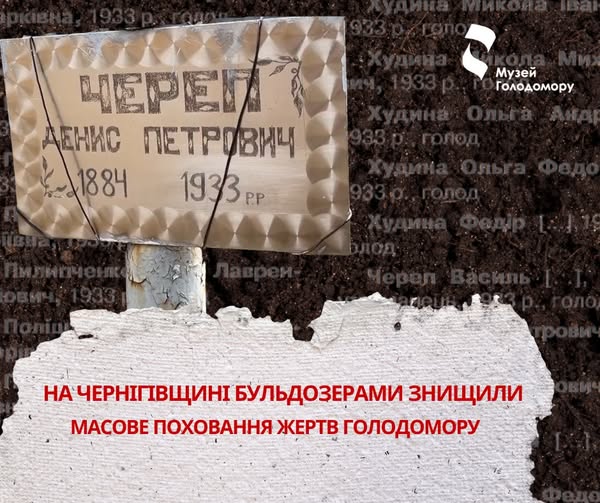In Chernihiv region, local authorities destroyed a cemetery with Holodomor victims’ graves. What is known?
25 March 17:52
In the village of Ivkivtsi, Chernihiv region, bulldozers razed to the ground a cemetery with the graves of victims of the Holodomor of 1932-1933. The village council stated that according to the documents, there is no cemetery there, and called the work landscaping.
This was reported by the National Museum of the Holodomor Genocide, "Komersant Ukrainian" reports.
The incident was first reported by journalists of the local Pryluky TV channel. They went to the village and saw bulldozers and other equipment working at the mass grave site.
Local residents say that no one warned them about the work at the cemetery. They immediately appealed to the village head to stop the work, as many of them had relatives buried there.
According to Mykola Danilishin, a resident of Ivkiv, his grandfather Denys Cherep is buried there. According to him, a third of this cemetery was filled during the Holodomor.
“People were dying. They were transported in carts and buried like cattle, without coffins. My grandfather was buried in the same way. They took everything from the house, even the beans, everything was raked out… They dug a hole for my grandfather, and by the time they brought him in a cart, four people were already lying there. People could not even dig holes, they had no strength,” said Mykola Danilishin.
What do the local authorities say?
Roman Yuvchenko, the village head, explained that the work at the cemetery site is carried out by the decision of the executive committee and in accordance with the improvement program. He added that the area where the work is being carried out is not listed as a cemetery in the territorial community plan.
What does the Holodomor Museum say?
However, the museum emphasized that the cemetery in Ivkivtsi is listed as one of more than a thousand mass graves on the territory of Ukraine in the geographic information system “Places of Mass Graves of the Holodomor Genocide Victims,” which was created by the Holodomor Museum staff in 2019.
According to the National Book of Memory, at least 162 people died of starvation in Ivkivtsi during the Holodomor, including a large number of children. And these are only those whose names have been established. Most of the dead are buried here, in the old cemetery. The villagers still visit the graves of their relatives.
The National Museum of the Holodomor Genocide appealed to the head of the Ladanska TG and the head of the Pryluky District State Administration to inform them of the value and importance of preserving this Holodomor-era burial site, as well as to restore order in the memorial area and properly mark it.
The Holodomor of 1932-1933
The USSR leadership organized an artificial mass famine in Ukraine in 1932-1933 to drive Ukrainian peasants into collective farms and break national resistance, the Ukrainian Institute of National Memory pointed out.
It noted that the scale of the lies and falsifications of the communist totalitarian regime was so great that scholars still cannot name the exact number of people killed – academic discussions cite figures of 4 to 10 million victims.
In 2002, the Ukrainian parliament adopted a resolution and in 2006 a law recognizing the Holodomor of 1932-1933 as genocide against Ukrainians. This was followed by more than 30 other countries, as well as the Catholic Church and the Ecumenical Patriarchate.
Many countries and institutions condemned the Holodomor after the start of the full-scale invasion, including the European Parliament and PACE. The Romanian parliament recognized the Holodomor as a crime against humanity and the Ukrainian people, and the Austrian parliament called it a “heinous crime.”









